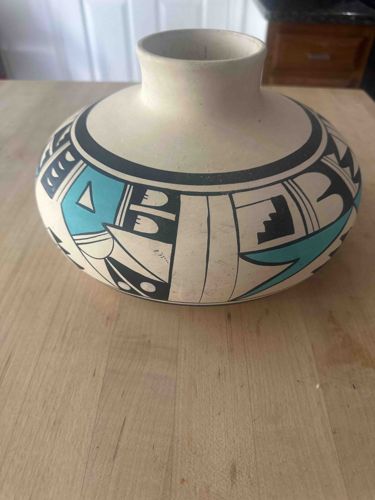
Native American Pueblo Pottery Jar
This is a hand-coiled ceramic pottery jar, likely of Native American Pueblo origin, possibly from the Acoma or Zuni tradition given its design elements and coloration. The piece possesses a rounded, squat body that tapers to a relatively narrow neck and a simple, slightly everted rim. The predominant color of the pottery body is a light buff or cream, characteristic of natural clay firing. The surface is adorned with intricate geometric patterns executed in black, white, and a distinct turquoise-blue pigment. The black outlines define bold shapes, while the turquoise fills in certain sections, creating a striking contrast. White areas within the black outlines also contribute to the design. The patterns appear to be continuous around the circumference of the jar, primarily concentrated around the widest part of the body, leaving the neck and base undecorated. Specific motifs include stepped designs, stylized feather-like elements, and angular shapes. The craftsmanship suggests traditional hand-coiling and painting techniques. No obvious chips, cracks, or repairs are visible from the provided images, but there are some visible scuff marks and dirt accumulation, particularly on the neck and body areas, indicating use or handling and a modest amount of wear consistent with age. The matte finish of the painted areas suggests natural mineral or plant-based pigments. There are no discernible maker's marks or signatures visible from this angle. The overall aesthetic points to an indigenous craft, likely from the mid-20th century to contemporary period.
AI-Generated Appraisal Disclaimer
Estimated Value
$400-700
Basic Information
Category
Ceramics
Appraised On
December 4, 2025
Estimated Value
$400-700
Item Description
This is a hand-coiled ceramic pottery jar, likely of Native American Pueblo origin, possibly from the Acoma or Zuni tradition given its design elements and coloration. The piece possesses a rounded, squat body that tapers to a relatively narrow neck and a simple, slightly everted rim. The predominant color of the pottery body is a light buff or cream, characteristic of natural clay firing. The surface is adorned with intricate geometric patterns executed in black, white, and a distinct turquoise-blue pigment. The black outlines define bold shapes, while the turquoise fills in certain sections, creating a striking contrast. White areas within the black outlines also contribute to the design. The patterns appear to be continuous around the circumference of the jar, primarily concentrated around the widest part of the body, leaving the neck and base undecorated. Specific motifs include stepped designs, stylized feather-like elements, and angular shapes. The craftsmanship suggests traditional hand-coiling and painting techniques. No obvious chips, cracks, or repairs are visible from the provided images, but there are some visible scuff marks and dirt accumulation, particularly on the neck and body areas, indicating use or handling and a modest amount of wear consistent with age. The matte finish of the painted areas suggests natural mineral or plant-based pigments. There are no discernible maker's marks or signatures visible from this angle. The overall aesthetic points to an indigenous craft, likely from the mid-20th century to contemporary period.
Get Your Items Appraised
Instant estimates of your treasures with AI-powered instant appraisals